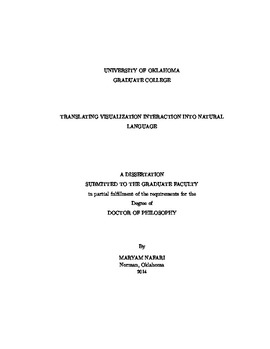| dc.description.abstract | Richly interactive visualization tools are increasingly popular for data exploration and analysis in a wide variety of domains.
Recent advancements in data collection and storage call for more complex analytical tasks to make sense of readily available datasets. More complicated and sophisticated tools are needed to complete those tasks. However, as these visualization tools get more complicated, it becomes increasingly difficult to learn interaction sequences, recall past queries asked from a visualization, and correctly interpret visual states to forage the data. Moreover, the high interactivity of such tools increases the challenge of connecting low-level acquired information to higher-level analytical questions and hypotheses to support, reason, and eventually present insights. This makes studying the usability of complex interactive visualizations, both in the process of foraging and making sense of data, an essential part of visual analytic research. This research can be approached in at least two major ways. One can focus on studying new techniques and guidelines for designing interactive complex visualizations that are easy to use and understand. One can also focus on keeping the capabilities of existing complex visualizations, yet provide supporting capabilities that increases their usability. The latter is an emerging area of research in visual analytics, and is the focus of this dissertation.
This dissertation describes six contributions to the field of visual analytics. The first contribution is an architecture of a query-to-question supporting system that automatically records user interactions and presents them contextually using natural written language. The architecture takes into account the domain knowledge of experts/designers and uses natural language generation (NLG) techniques to translate and transcribe a progression of interactive visualization states into a log of text that can be visualized.
The second contribution is query-to-question (Q2Q), an implemented system that translates low-level user interactions into high-level analytical questions and presents them as a log of styled text that complements and effectively extends the functionality of visualization tools.
The third contribution is a demonstration of the beneficial effects of accompanying a visualization with a textual translation of user interaction on the usability of visualizations. The presence of the translation interface produces considerable improvements in learnability, efficiency, and memorability of visualization in terms of speed and the length of interaction sequences that users perform, along with a modest decrease in error ratio.
The fourth contribution is a set of design guidelines for translating user interactions into natural language, taking into account variation in user knowledge and roles, the types of data being visualized, and the types of interaction supported.
The fifth contribution is a history organizer interface that enables users to organize their analytical process. The structured textual translations output from Q2Q are input into a history organizer tool (HOT) that imposes reordering, sequencing, and grouping of the translated interactions. HOT provides a reasoning framework for users to organize and present hypotheses and insight acquired from a visualization.
The sixth contribution is a demonstration of the efficiency of a suite of arrangement options for organizing questions asked in a visualization. Integration of query translation and history organization improves users' speed, error ratio, and number of reordering actions performed during organization of translated interactions. Overall, this dissertation contributes to the analysis and discovery of user storytelling patterns and behaviours, thereby paving the way to the creation of more intelligent, effective, and user-oriented visual analysis presentation tools. | en_US |
